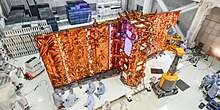SAOCOM
SAOCOM (Satélite Argentino de Observación COn Microondas, Spanish for Argentine Microwaves Observation Satellite) is an Earth observation satellite constellation of Argentina's space agency CONAE. The first of two satellites is already orbiting the Earth in a polar orbit, while the second one is planned to be launched in 2020.
 Mockup of the SAOCOM satellite. | |
| Mission type | Earth-observation satellites |
|---|---|
| Operator | CONAE |
| COSPAR ID | 2018-076A (SAOCOM-1A) |
| SATCAT no. | 43641 |
| Website | |
| Mission duration | 5 years (planned) |
| Spacecraft properties | |
| Spacecraft | SAOCOM |
| Bus | SAC-C |
| Manufacturer | INVAP |
| Launch mass | 3000 kg |
| Dry mass | 1600 kg |
| Start of mission | |
| Launch date | 8 October 2018, 02:21 UTC (SAOCOM 1A) August 2020 (SAOCOM 1B) (planned) |
| Rocket | Falcon 9 |
| Launch site | Vandenberg Air Force Base, SLC-4E (SAOCOM 1A) CCAFS, SLC-40 (SAOCOM 1B) |
| Contractor | SpaceX |
| Orbital parameters | |
| Reference system | Geocentric orbit |
| Regime | Low Earth orbit |
| Altitude | 620 km |
| Inclination | 97.89° |
| Period | 97.2 minutes |
| Repeat interval | 16 days |
| Epoch | 8 October 2018 |
CONAE contracted the company INVAP as main contractor for the project.
Configuration
The two satellites, SAOCOM 1A and SAOCOM 1B, both are equipped with an L band (about 1.275 GHz) full polarimetric Synthetic Aperture Radar (SAR) to help predict and monitor the mitigation of natural disasters. Each satellite has a mass of 3,000 kg (6,600 lb).[1]
History

Due to delays in the development of satellites, both launches were postponed for 2012 and 2013.[2] Further delays pushed the launch dates back tentatively towards 2014 and 2015.[3] By 2016, SAOCOM 1A was scheduled for launch in December 2016,[4] and SAOCOM 1B in December 2017.[5] In April 2016, the launch dates for 1A and 1B were further pushed back to October 2017 and October 2018.[6] In August 2018, SAOCOM 1A was scheduled for launch on 7 October 2018[7] and SAOCOM 1B some time in 2020.[8] Both satellites were to be launched on Falcon 9 rockets[9] together with additional secondary payloads.[10]
SAOCOM 1A
INVAP is the prime contractor for the design and construction of the SAOCOM spacecrafts and its SAR payloads. The SAOCOM-1A spacecraft benefit from the heritage of the SAC-C spacecraft platform.[11]
Synthetic Aperture Radar (SAR-L), an L-Band instrument featuring standard, high resolution and global coverage operational modes with resolution ranging from 7 m to 100 m, and swath within 50 km to 400 km. It features a dedicated high capacity Solid State Recorder (50 to 100 Gbits) for image storage, and a high bit rate downlink system (two X-band channels at 150 Mbits/s each).[11]
The SAOCOM system operates jointly with the Italian COSMO-SkyMed constellation in X-band to provide frequent information relevant for emergency management. This approach of a two SAOCOM and a four COSMO-SkyMed spacecraft configuration offers an effective means of a twice-daily coverage capability. By joining forces, both agencies are able to generate SAR products in X-band and in L-band for their customers.[11]
SAOCOM 1B
A SpaceX Falcon 9 rocket will launch the SAOCOM 1B satellite for CONAE, Argentina's space agency. SAOCOM 1B is the second of two SAOCOM 1-series Earth observation satellites designed to provide radar imagery to help emergency responders and monitor the environment, including the collection of soil moisture measurements. Delayed from January 2020. This mission was originally scheduled to launch from Vandenberg Air Force Base, California. But SAOCOM B will be launched from Cape Canaveral.[12]
Launch and operations
SAOCOM 1A was launched on 8 October 2018, at 02:22 UTC. The satellite was deployed into a Sun-synchronous orbit.[13] The Falcon 9 rocket booster landed as planned at Landing Zone 4 at the Vandenberg Air Force Base, making it SpaceX's first land landing for a launch occurring on the Pacific coast.[13]
The same orbit is planned to be used for SAOCOM 1B on launch from Cape Canaveral Air Force Station, since the pad SLC-40 in August 2020.
SIASGE constellation
The two satellites, also carry four X band (~9.6 GHz) SAR-equipped COSMO-SkyMed satellites from the Italian Space Agency (ASI), that will form the Italian-Argentine System of Satellites for Emergency Management (Sistema Italo-Argentino de Satélites para la Gestión de Emergencias) (SIASGE) constellation.[14] A successful design review was held at the Argentinian space centre Teófilo Tabanera near the Cordoba City on 16 and 17 October 2012. In May 2015, the two agencies decided to expand the SIAGSE system by adding two additional COSMO-SkyMed satellites and two additional SAOCOM satellites, 2A and 2B. This would raise the SIAGSE constellation total number of satellites to 10.
References
- "INVAP - SAOCOM satellites" (PDF). Retrieved 3 May 2015.
- "SPACEX SIGNS ARGENTINA'S SPACE AGENCY FOR TWO FALCON 9 LAUNCHES". Space Exploration Technologies Corp. 16 April 2009. Retrieved 3 May 2015.
- "Launch manifest". SpaceX. 2012. Retrieved 20 March 2012.
- "Mission Summary - SAOCOM 1A". CEOS. Retrieved 16 February 2016.
- "Mission Summary - SAOCOM 1B". CEOS. Retrieved 16 February 2016.
- "Exitosa Revisión de la Misión SAOCOM" (in Spanish). CONAE. 12 April 2016. Retrieved 27 April 2016.
- Clark, Stephen (27 August 2018). "Launch schedule". SpaceFlight Now. Retrieved 28 August 2018.
- "Agencias espaciales del mundo debatieron en Buenos Aires cómo prevenir catástrofes naturales" [Space agencies of the world will debate in Buenos Aires how to predict natural disasters]. Los Andes (in Spanish). 8 September 2017. Retrieved 23 September 2017.
Este sistema ítalo-argentino estará completo cuando se lancen los dos satélites SAOCOM 1A y SAOCOM 1B, que serán puestos en órbita en junio de 2018 y a comienzos de 2019, respectivamente.
- http://space.skyrocket.de/doc_sdat/saocom-1.htm
- http://space.skyrocket.de/doc_sdat/itasat-1.htm
- "SAOCOM 1A". nssdc.gsfc.nasa.gov. NASA. Retrieved 27 February 2020.

- https://spaceflightnow.com/launch-schedule/
- Arias, Daniel E. (9 June 2007). "Ya en órbita, el satélite Cosmo-Skymed da sus primeros signos de vida" (in Spanish). La Nación. Retrieved 31 August 2007.
External links
- SAOCOM Official Website(in Spanish)
- SAOCOM.INVAP Official Website{Argentina space program}}

